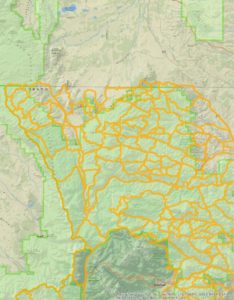 Potential Operational Delineations (PODs) are a strategic planning tool developed using a combination of local expertise and advanced spatial analysis. They identify the safest and most effective control lines used to contain a wildfire and can assist in integrating land management objectives and incident response. A new report developed by CFRI’s Mike Caggiano, and partners at the Rocky Mountain Research Station and Oregon State University presents an overview of Potential Operational Delineations (PODs), discusses how to develop PODs collaboratively by engaging stakeholders, identifies associated information products, maps, and reports that can assist in land use planning and fire response, and notes observations and lessons learned from facilitating POD development workshops on multiple Forests.
Potential Operational Delineations (PODs) are a strategic planning tool developed using a combination of local expertise and advanced spatial analysis. They identify the safest and most effective control lines used to contain a wildfire and can assist in integrating land management objectives and incident response. A new report developed by CFRI’s Mike Caggiano, and partners at the Rocky Mountain Research Station and Oregon State University presents an overview of Potential Operational Delineations (PODs), discusses how to develop PODs collaboratively by engaging stakeholders, identifies associated information products, maps, and reports that can assist in land use planning and fire response, and notes observations and lessons learned from facilitating POD development workshops on multiple Forests.
PODs provide a big picture perspective summarizing risk and opportunities across the landscape, and help translate land management objectives into on-the-ground strategies and tactics. Because they pre-identify control lines where wildfires are most likely to be effectively suppressed, PODs are operationally relevant and can inform indirect incident response strategies that: reduce risk to high-valued assets including homes and utility infrastructure, and minimize the exposure of firefighters tasked with suppressing the fire. PODs can be used when wildfires prove difficult to suppress through direct attack, when the values at risk do not necessitate putting firefighters at risk, or when it has been determined that reintroducing fire in a particular area will promote ecological health or align with land management objectives. PODs can also be used for planning and communication purposes. Some Forests are using PODs in conjunction with quantitative risk assessments to identify strategic response zones and quantitatively predict how values at risk would respond to different levels of fire intensity (Figure 2). Doing this enables managers to collaboratively identify areas where fire needs to be suppressed, areas where fire could help achieve ecological objectives, and areas where fire might have a positive effect on resources depending on conditions.
